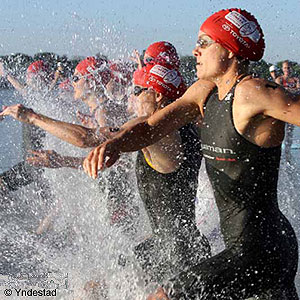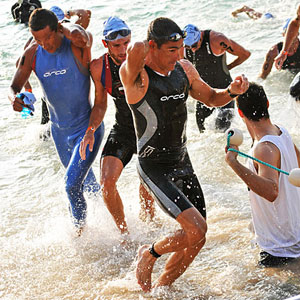Beginners: Week 4
You're swimming and running, right? Now we're going to look at the bike.
The bike is that part of triathlon that probably is least impactful on your overall finish time, but most impactful on your free time. What I mean is, if you're a really bad swimmer you can lose gobs of time. If you're particularly good, you can gain a lot of time. Likewise, the run is where these races are won and lost. If you've got a weak link, best to have it be cycling.
The hell of it is that the bike is precisely that segment which is responsible for an awful lot of training time––versus the other two events––and it's also the proximate cause for a great lessening of your bank account balance (polls taken show triathletes spend half their tri budget on thebike, the other half on the swim, the run, race entries, and race travel). People who really get into triathlon have been known to drop a lot of money on bike stuff (and I’m a very bad example of one who spends very good money on way more bike stuff than I’ll ever need).
MISSION
You can do this race on any bike you want. What's in your garage? A mountain bike? No problem! Do the race on that. Whatever. But here's the thing. Don't go out and by a "triathlon bike" if you're a beginner. If you must buy a new bike, buy a road race bike. These are the kinds of bikes that the Tour de France guys ride in their group races. There are plenty of reasons why you want to start with this kind of bike. Even top pro triathletes have bikes like this in their garages, and they ALL ride them quite a bit. So it's not a wasted or interim investment.
I've seen some very nice road race bikes for sale in the $800 range, by Specialized, Giant, Trek, Cannondale, Felt and other companies. These are bikes a pro bike racer could hop onto and acquit himself quite well. There are pretty decent bikes that I've seen in the $600 – $700 range.
But there are some other things you'll need. Like the garb. Primarily, you'll need cycling shoes, cycling pedals, cycling shorts, and a cycling helmet. Don't overspend! All that stuff––shoes, helmet, pedals, and two pairs of shorts, can be had for perhaps $150 total if you look around and aren't too picky. Go to our forum and ask where to buy this stuff cheap. Plenty of people (including me) will answer.
You'll also need to get a couple of spare tubes, tire tools, perhaps a foldable Allen wrench set, and a little bag that goes behind your saddle to hold your tools and spare tube. Total expense? $25 – $30. And make sure you know how to change a flat tire.
Get a pair of water bottle cages for your bicycle's down tube and seat tube, and a few bottles. Another $15 or $20 total for all that. Keep your bottles clean.
Finally, there is a middle ground to all this expense. You can keep your mountain bike, but still get the shorts, pedals, shoes, tubes, cages, bottles, helmet, and all that stuff. That means you're about $200 poorer. If you decide at some point to move to a road race bike, all that stuff will transfer over to your new bike (except the spare tubes, which are only $10 of that total $200 investment).
EXECUTION
Let's throw in one longer run or run/walk this week. No biking yet, but get yourself set up with cycling stuff so that you can commence bike workouts next week.
SWIMMING: 2 OR 3 SESSIONS X 500 – 1500 YARDS PER SESSION
CYCLING: NONE
RUNNING: 3 SESSIONS X 25 MINUTES PER SESSION; 1 X 45 MINUTES




Start the discussion at slowtwitch.northend.network